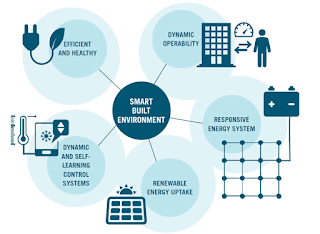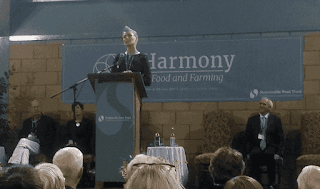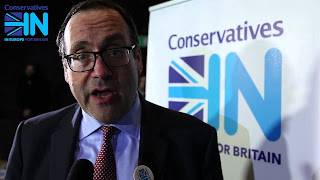A version of this piece was published on The Fifth Estate on 18 July 2017
“Food is the biggest driver of climate change,” she said at a conference I attended recently. “As two billion more people will be added to the planet this century and more people become affluent, more will eat meat and there is no scientific consensus on solving these interconnected problems. We need action to change this and to end the disconnect between consumption and production”.
 |
| Public planting session in Andernach. |
Integrated design includes food growing
It was started by geoecologist Lutz Kosack, who works in the city planning office on urban land conservation measures, and the horticulture engineer Heike Boomgaarden, who developed what Kosack calls a “sustainable building kit system for municipal green space planning, whereby ecological, economic and social aspects were integrated into an overall concept”. |
| The sign reads 'Picking allowed, not entering forbidden!'. |
 |
| This plan gives an idea of what has been planted where. |
 |
| The permaculture site from the air. |
Huge spin-off benefits
There are many spin-off benefits: the green spaces and projects create meeting places, people are healthier and brownfields are transformed into bee pastures. The long-term unemployed are supported to take part, to gain skills and qualifications. The permaculture holding offers employment, including to refugees, generates revenues from sales of meat, and creates a market for regional products.…and local government pays salaries to make it work
It was not a grassroots initiative, but the project of a far-sighted city administration, which pays the salaries of those involved and makes the land available. In 2012, Kozack, Boomgaarden and Andreas Görner founded the company “Esslich – Büro für urbane Pflanzkultur”. They have all gone on to spread the concept throughout Germany.
The city’s genetic diversity is extended every year with selected vegetable varieties. Kozack says: “We preferably work with regional plants. Our native flora is much more valuable to wild animals than imported and highly cultivated species, because they have developed over thousands of years and are optimally adapted to each other, as well as adapted to our climate and our soils. Combined with an organic soil improvement and homeopathic plant protection is a solid foundation laid.
“We want to make people experience sustainability that does not mean renunciation but wealth, beauty and harmony”
“We have now professionalised this concept of regionality with the “1 square mile homeland” (2.59 sq km) concept. We want to make people experience sustainability that does not mean renunciation but wealth, beauty and harmony.”
The project has won several awards. The chairman of DUH (one of the award-givers, the German Environmental Help Foundation), Prof. Harald Kächele, observed: “Urban gardening is currently in great demand in many cities in Germany. But the concept of Andernach is unique. Because it addresses all the city residents and beckons them on each walk past the beds to sow and harvest themselves, and thereby change the cityscape in a positive way. ”
Livestock, such as rare breeds of chicken, sheep and pigs are also kept. In 2013, the then mayor, Achim Hütten, said, “We encourage our citizens to enter the flower beds, monitor the growth of green cabbage and so on, and finally harvest and taste them. This is very popular with the residents”.
A city for all, a citizen’s garden
It is a city garden for all citizens, a real citizen’s garden.Andernach has now become a centre where other cities have come to learn how to do the same thing. As many as 90 other cities in Germany have taken up the idea. For example, Minden, in the springtime, all citizens are invited to a weekend where they plant seeds and seedlings in public places.
In Seattle, they’re also transforming public space into edible gardens
The concept is spreading in the USA too. In the city of Seattle the Beacon Food Forest is intended to transform a public area into an edible permaculture forest. Around 2100 sq m of land has been planted with hundreds of fruit trees, berry bushes, vegetables and herbs, which can be harvested by walkers and residents. The area includes playgrounds, lawns and community gardens for residents’ use.
The origin of all of these projects, Kosach and Boomgaarden acknowledge, can in some way be traced back to a small town in Yorkshire in the north of England.
It probably all started in Yorkshire
Incredible Edible Todmorden has been running since 2007 and inspired a great many copycat projects in towns all over the UK and beyond. These are pretty much all, unlike Andernach, grassroots-initiated, though many have secured the cooperation of the local authority.The Todmorden project was the brainchild of Pamela Warhurst, Mary Clear and a group of like minded people, who, as they describe in the recent film about the Transition movement, Demain (Tomorrow), just wanted to plant some fruit and veg in vacant spaces in their town. Their idea has fertilised minds far beyond what they could ever have expected at the time. “Our motto was, just do it!” says Pamela in the film.
The Incredible Edible Network lists as members over 100 groups across the UK and many others in Australia, Canada, France and the USA. Its website contains a starter kit and helpful videos for anyone wanting to begin a group in their own area.
Urban gardens can be more productive
According to the UN Food and Agriculture Organisation, garden plots can be up to 15 times more productive than rural holdings with just one square metre capable of providing 20 kilograms of food a year. The food footprint is correspondingly much smaller than imported food. Urban agriculture can generate one job every 100 sq m in production, input supply, marketing and value-addition from producer to consumer.For all the above reasons, urban growing deserves to be much higher up the agenda of town and city authorities everywhere.
David Thorpe is the author of The One Planet Life, a Blueprint for Low Impact Living. See his website here.
















